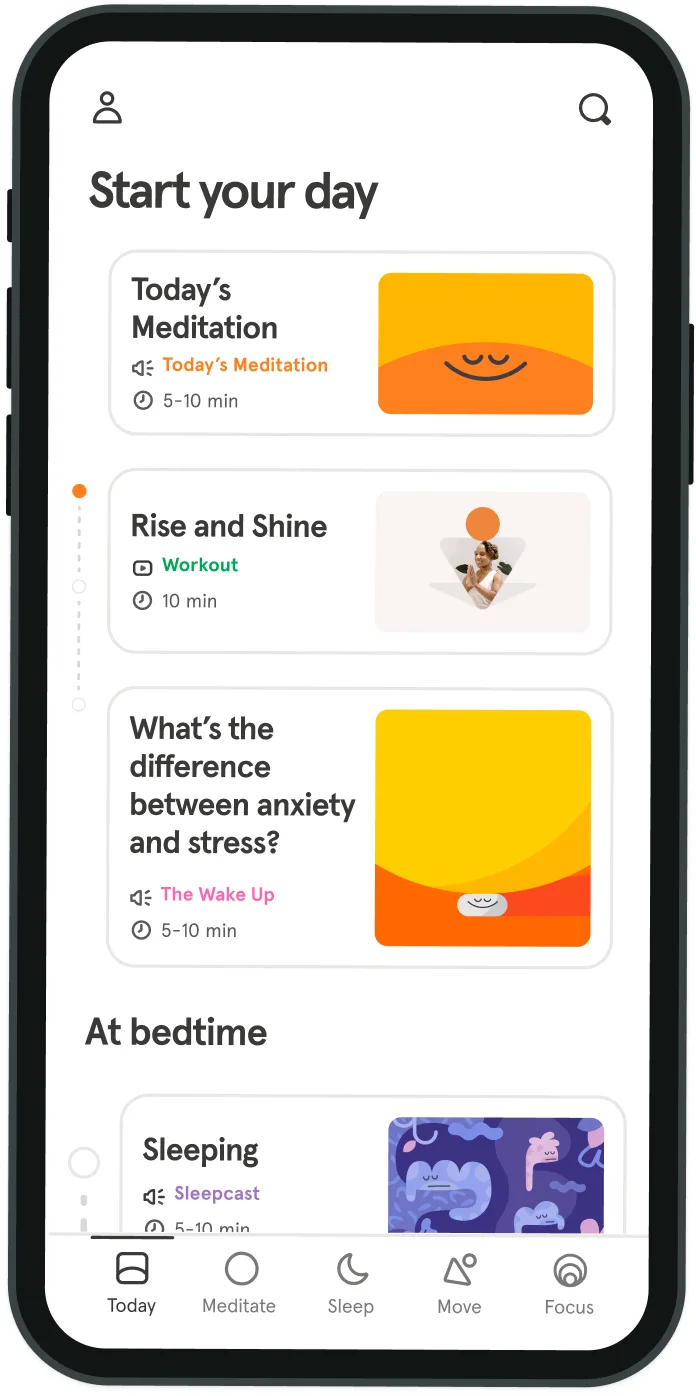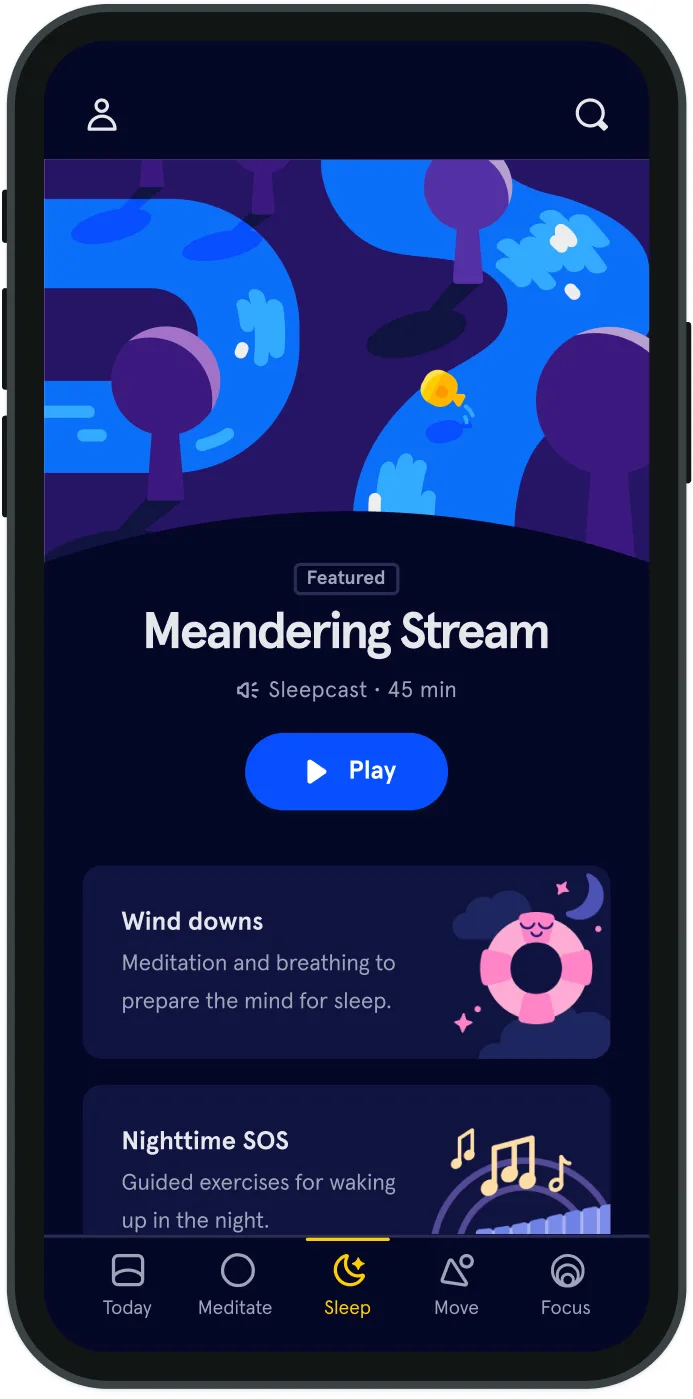What people get wrong about meditation
Let’s play a game of free association. When I say meditation, what’s the first thing that pops into your head? Headspace doesn’t count. Here’s a list of responses I’ve collected from friends and unsuspecting strangers on public transit: New Age, hippies, crunchy, granola, organic, yoga, yuppies, Buddhism, strict, silence, stationary, sitting cross-legged, gongs, deep breathing, and time consuming.
There are plenty of stereotypes out there about meditation and what it entails, very few of which have ever been true for my experience. If you’re a part of the Headspace community, chances are that you’ve encountered many of these misconceptions already. Such ideas might even be obstacles to get your family and friends on board, even though you know they could reap the benefits of meditation if they’d just give it a chance. While mainstream attitudes are shifting around meditation, there’s still work to do. It’s about time these myths got debunked. Myth #1: Meditation is for a certain type of person Although meditation is rooted in Eastern tradition, its widespread adoption by Western hippies during the 1960s has left a lasting impression. To this day, many people think of the practice of meditation as a component of a New Age lifestyle, practiced either by hippies or yuppies (sometimes one and the same). These folks can be overheard swapping stories about their chakras in the Whole Foods checkout line, shopping carts overflowing with organic yogurt, granola, and kombucha. The hippies ride bikes to yoga class while yuppies carpool in Priuses to meet them there. Neither group would be caught dead in a McDonald’s (unless the hippies were protesting). While the crystal-toting crowd might practice meditation, they certainly aren’t the only ones. I’ve never set foot on a yoga mat in my life, I thought a chakra was a type of jewelry for far too long, yet I meditate daily (my nonprofit office even has a meditation space). Employees at big-time corporations like Apple, Nike, and HBO take time for mindfulness during the workday. Budding business entrepreneurs meditate as a form of professional development. NBA star Kobe Bryant meditates to improve his athletic performance. It doesn’t matter what the practitioner’s hobbies are, or where he/she comes from. People from all backgrounds, lifestyles, and professions can practice mindfulness. You could even complete a mindful eating exercise while eating a Big Mac. Bottom line: anyone can practice and tailor it to suit unique needs and lifestyle—no drum circle required. Myth #2: Meditation is religious Although this practice is rooted in Eastern Buddhist tradition, its actual implementation can be entirely secular. Sure, even Headspace co-founder, Andy, was an ordained Tibetan Buddhist monk who studied meditation first in the Himalayas then around the world. Yet while he draws upon the roots of the practice, Headspace provides a new look at meditation that isn’t tied to any singular religious identity. Many religions include some type of meditation, but it seems most commonly affiliated with Buddhism. I was raised Catholic, and the repetitive rosary prayer beads were my gateway into mindfulness. Hinduism and Judaism include a meditation component, too, as with many other faiths. Mindfulness has been scientifically proven to boost participants’ emotional and physical health. This reason alone attracts both believers and atheists alike. It’s a way to boost one’s awareness of both internal and external factors; this basic foundation can be shaped to suit either religious or secular purposes. Take a look at Headspace’s categories and you’ll find that all are general enough to offer room for personal interpretation.
Myth #3: Meditation is serious A quick Google image search for “meditation” results in way too many stock images of participants sitting in Om pose with legs crossed, eyes closed, arms and hands extended. Their faces are largely emotionless and stoic, like boring figures in a wax museum. Sure, sometimes I mimic these stock photo models. But more often than not, my sessions are emotional and active. I often use meditation to work through serious, difficult issues that life unexpectedly tosses at me. Mindfulness has helped me cope with the loss of loved ones, workplace stress, and social anxiety—all the fun stuff. It’s my meditation and I’ll cry if I want to (I often do). Sometimes you just need to let it all out in order to process and move on. My awareness is heightened during meditation, which triggers my emotions as well. I may not own a yoga mat, but I’ll admit to toting a box of Kleenex to a session. Sometimes I find myself grinning like a Cheshire cat or laughing out loud—it all depends on my state of mind and what I’m choosing to focus on during that particular exercise.
Myth #4: Meditation requires too much planning Revisiting the depiction of meditators in the Om pose from our previous myth: the last time I sat that way was in 2012. Sure, it can be a great way focus the mind and body, but I rarely plan meditation sessions ahead of time, and I tend to complete exercises in spaces where that pose might be a bit awkward. Take, for instance, my semi-regular morning practice. I hop on the crowded train to take my daily thirty-minute ride into the office. Nestled snuggly between a fellow rider’s armpit and a talkative couple, I slip on my headphones and escape via meditation. Unexpected projects at work or difficult interactions with clients tend to result in impromptu visits to our office meditation room. I plan to meditate for at least twenty minutes a day, but the how and when aspects of my schedule tend to be pretty organic. I also work to improve my practice whenever the opportunity presents itself, like practicing meditative breath while in the shower or painting my nails. I also try to apply the lessons learned in sessions to my everyday life, like running through my body while at the gym. While I acknowledge that the focus on breathing is important to the practice, when in a bind, I find that my deep breaths on the treadmill are still sufficient. Now, think again about meditation. What’s the first thing that pops into your head this time? Hopefully it’s you, whoever you are. Mindfulness is about the way you relate to the world around you—however that relationship might look. Make it what you want it to be.

Mindfulness has helped me cope with the loss of loved ones, workplace stress, and social anxiety
Meg Mankins


Be kind to your mind
- Access the full library of 500+ meditations on everything from stress, to resilience, to compassion
- Put your mind to bed with sleep sounds, music, and wind-down exercises
- Make mindfulness a part of your daily routine with tension-releasing workouts, relaxing yoga, Focus music playlists, and more
Meditation and mindfulness for any mind, any mood, any goal

Stay in the loop
Be the first to get updates on our latest content, special offers, and new features.
By signing up, you’re agreeing to receive marketing emails from Headspace. You can unsubscribe at any time. For more details, check out our Privacy Policy.
- © 2025 Headspace Inc.
- Terms & conditions
- Privacy policy
- Consumer Health Data
- Your privacy choices
- CA Privacy Notice
